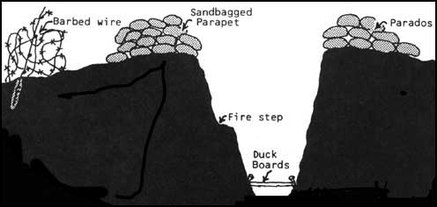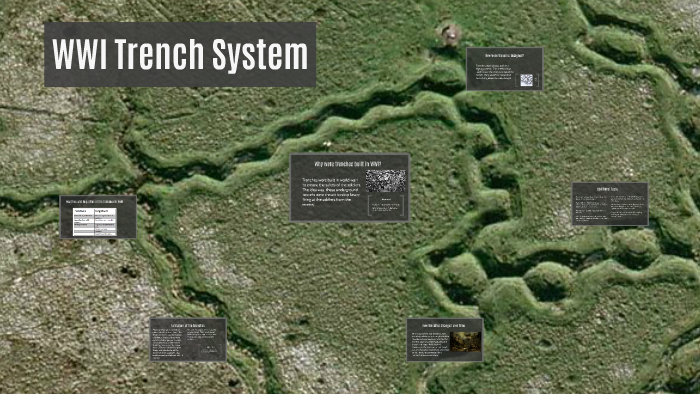There would still be soldiers on defense they have walls to hide behind. Why did zigzag attack Stanley.

Wwi Trench Warfare Lesson For Kids Explanation Facts Study Com
The civilian population and their activities of a country at war.
. Another very important reason for the trench being zigzag is that if a-bomb or shell landed in the trench the blast could not travel far. Why were trenches dug in a zig zag pattern. The trenches were dug by soldiers and there were three ways to dig them.
To make defending easier. Zigzag attacked Stanley because Stanley was. All the trenches were dug in a zig-zag pattern so the enemy couldnt shoot straight down the line and kill many soldiers.
The WWI trenches were built as a system in a zigzag pattern with many different levels along the lines. If a mortar grenade or artillery shell would land in the trench it would only get the soldiers in that section not further down the line. Trenches were designed in zigzag patterns so enemies that penetrated defenses were limited in their lines of fire.
Trenches were dug in this way that if there was a blast from an exploding shell it would be confined to small section of the trench. All the trenches were dug in a zig-zag pattern so the enemy couldnt shoot straight down the line and kill many soldiers. An advantage of the trenches was that they were dug in a zigzag pattern to prevent the enemy from firing down the line.
The main trench lines were connected by communicating trenches allowing for the movement of messages supplies and soldiers and were lined with barbed wire. Most of the trenches had zigzag patterns so that if an enemy soldier somehow made it into their trench he couldnt fire straight down the line. The main trench lines were connected by communicating trenches allowing for the movement of messages supplies and soldiers and were lined with barbed wire.
These were meant to protect the soldiers feet from the water in the trenches to try and prevent Trench Foot. All the trenches were dug in a zig-zag pattern so the enemy couldnt shoot straight down the line and kill many soldiers. Trenches were dug in a zigzag pattern so that if an enemy entered the trench he could not fire straight down the line.
Why were the trenches built. If a mortar grenade or artillery shell would land in the trench it would only get the soldiers in that section not further down the line. If a mortar grenade or artillery shell would land in the trench it would only get the soldiers in that section not further down the line.
Why were trenches dug in a zigzag pattern. A typical trench system included a line of three or four trenches. The trenches were dug by soldiers and there were three ways to dig them.
Why were ww1 trenches built in a zigzag design. Why Were The Trenches Built In Zig Zags. The trench system had a main fire trench or front line.
What was the purpose of barbed wire. However if the trench was zigzag even if the enemy managed to get in the trench they could only control part of it. The front line was the first line of defense and attack for the trenches.
Name one of the German commanders on the Eastern front. Trenches were dug in a zigzag pattern so that if an enemy entered the trench he could not fire straight down the line. So enemy troops couldnt fire a straight line all the way down the trench Why were trenches dug in a zigzag pattern.
Several parallel lines of trenches were dug and soldiers rotated between the front trenches support trenches and reserve trenches. Trench warfare developed its own tech tree in 1914 trenches were shallow and dug in roughly straight lines As the war stagnated into what was effectively a form of siege warfare artillery began to become the dominant weapon. Germany Austria-Hungary Russia.
Why were trenches dug in a zigzag pattern. They were dug in a zigzag pattern so that if an enemy breached the defenses and entered the trench he would not be able to kill a lot of soldiers since they would not. Because snipers were a constant threat periscopes and mirrors were used to observe the battlefield.
Trenches were dug in a zigzag pattern so that if an enemy entered the trench he could not fire straight down the line. Answer 1 of 5. The front line also called the outpost or the fire line the support trench and the reserve trench all built parallel to one another and anywhere from 100 to 400 yards apart.
The trench system had a main fire trench or front line. Trenches were dug in a zigzag pattern so that if an enemy entered the trench he could not fire straight down the line. The main trench lines were connected by communicating trenches allowing for the movement of messages supplies and soldiers and were lined with barbed wire.
The main trench lines were connected by communicating trenches allowing for the movement of messages supplies and soldiers and were lined with barbed wire. Why were trenches dug in a zig zag pattern. Trenches were dug in a zigzag pattern so that if an enemy entered the trench he could not fire straight down the line.
Trenches were dug in this way that if there was a blast from an exploding shell it would be confined to small section of the trench.

Box 1 Trench Warfare April Smith S Technology Class
Significance Of The Shape Of The Trench World War 1 Class 6
Why Were Trenches Dug In A Zigzag Pattern Quora




0 comments
Post a Comment